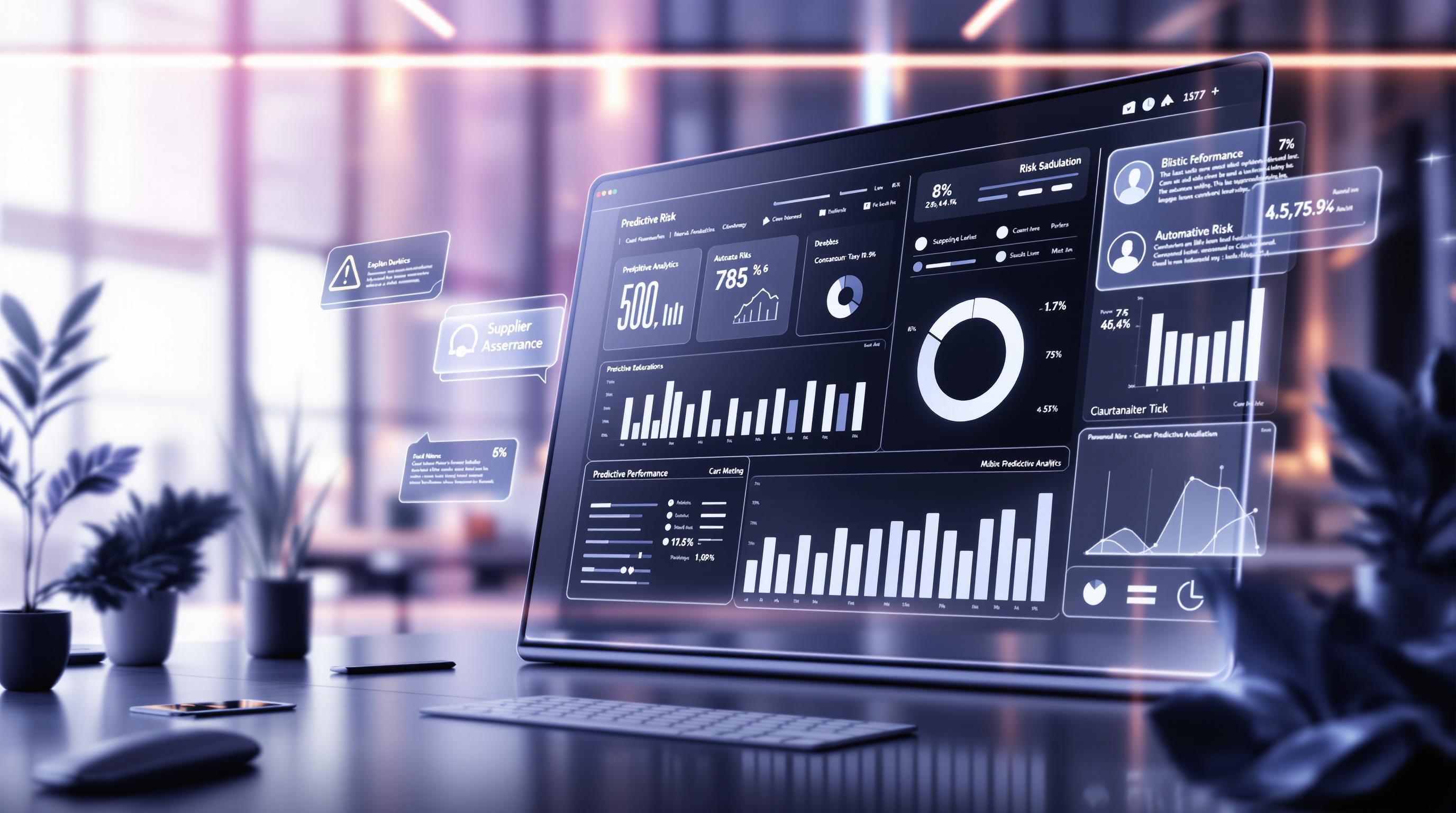Main Pages
AboutPricingSecurityCareerCustomersContactBlogFeatures
Monitor & EnrichDiscover & SourceRFI & EngageOur Socials
LinkedinLegal
Terms of UseMay 9, 2025
Explore how AI tools enhance supplier performance management through predictive analytics, risk assessment, and automated evaluations.
Articles

AI tools are transforming supplier performance management. They help businesses track trends, reduce risks, and improve supplier relationships with data-driven insights. Here’s how they make a difference:
Key Benefits:
AI-powered tools are transforming how businesses monitor and improve supplier performance. Here's a look at some of the top options available today.
Omnex Systems' SQM.AI stands out with its machine learning features designed for analyzing long-term trends [5]. By examining historical supplier data, it provides actionable insights with capabilities like pattern recognition and anomaly detection. The platform pulls real-time data from various sources, offering a detailed view of supplier performance over time.
LeewayHertz's supplier management system uses advanced algorithms to assess supplier risks [3]. Key functionalities include:
The platform detects potential risks early and suggests strategies to address them, helping businesses maintain a resilient supply chain.
Akira.ai's evaluation system uses machine learning and natural language processing to simplify supplier assessments [1]. Its features include:
This system minimizes manual work while improving accuracy in evaluating supplier performance.

Find My Factory elevates supplier evaluation with AI-driven search tools, enriched databases, and collaboration features. It also supports continuous performance monitoring and ensures secure data handling, making it easier to assess suppliers over the long term.
These tools give businesses the ability to integrate AI into their supplier management processes and make informed decisions with ease.
To effectively use AI tools for supplier performance analysis, businesses need to focus on both technical aspects and the human side of the process. A well-thought-out approach ensures these tools deliver actionable insights and measurable results.
Start with a detailed data audit to verify that supplier information is accurate and consistent. Poor data quality is one of the biggest reasons AI projects fail.
Here’s a simple breakdown of the implementation process:
1. Data Preparation Phase
Begin by organizing and standardizing all supplier data. This involves cleaning up inaccuracies, normalizing formats, and setting up protocols to validate new data moving forward.
2. System Integration
Integrate AI tools into your procurement systems using APIs and data mapping. For medium-sized businesses, this process typically takes about 2–3 months.
3. Training and Adoption
Provide hands-on training sessions using real supplier data. Starting with basic use cases can help increase adoption rates by as much as 75%.
AI implementation often comes with a set of hurdles, but these can be addressed with proactive strategies.
Data Integration Issues
Merging data from multiple sources can be tricky. To manage this:
Resistance to Change
Employees may resist new technologies. To ease the transition:
Technical Integration
Smooth technical integration requires planning. Involve IT teams early, test compatibility thoroughly, prepare backup plans, and set up ongoing support resources.
"By improving risk management practices and making more informed decisions, supply chain leaders can improve their bottom line and ensure that their business functions as efficiently as possible." - GraceBlood, Supply Chain Expert [2]
Keep monitoring and fine-tuning your strategies to ensure long-term success and a strong return on investment. With a solid foundation in place, businesses can explore upcoming AI advancements to further refine supplier performance analysis.
Machine learning is now analyzing large sets of historical data to predict supplier behavior and identify risks with improved precision. This is helping businesses better track and assess supplier performance, leading to smarter decision-making.
Tools like SourcingGPT.ai bring together AI and procurement expertise to recommend suppliers and simplify procurement processes [4]. Natural Language Processing (NLP) is also playing a big role by making sense of unstructured supplier data. Here's how it works:
Data SourceInsights or ImpactSupplier CommunicationsDetects sentiment to spot risks earlyContract DocumentsAutomates compliance checks to reduce legal risksMarket ReportsIdentifies trends for better planningPerformance ReviewsRecognizes patterns for predictive maintenance
AI is transforming procurement by improving risk management and supplier segmentation. It evaluates factors like financial health, market trends, and performance data to predict risks and rank suppliers based on their importance and risk levels [3].
Real-Time Performance Tracking Modern AI tools continuously monitor supplier performance, flagging both problems and opportunities as they arise. This live data helps businesses strengthen supplier relationships while staying ahead of potential issues.
Looking ahead, AI in supplier management is set to become even more advanced. Future systems will not only analyze past data but also offer actionable steps to enhance supplier partnerships. These improvements will make enterprise-level supplier management accessible to businesses of all sizes, strengthening supply chains and boosting efficiency.
As AI develops further, procurement teams can expect even more tools to help them navigate supplier relationships with ease and precision.
AI tools are reshaping supplier evaluations by automating tasks like compliance checks and spotting opportunities to cut costs. They combine various data sources to offer a complete picture of supplier reliability and overall value [1][3].
The use of technologies like predictive analytics and AI-powered scorecards has changed how businesses assess and manage suppliers. These tools evaluate several critical factors, such as:
Factor AnalyzedImpact on BusinessHistorical PerformanceHelps identify trends and predict outcomesFinancial StabilityLowers risk and ensures dependable suppliersCompliance HistorySupports adherence to regulations and qualityMarket DynamicsAids in strategic planning and managing risks
These features make AI tools a must-have for modern supply chain operations.
Platforms like Find My Factory simplify supplier discovery and improve supply chain efficiency. They're becoming easier to use and more affordable. To make the most of these tools, businesses need clean data, experienced teams, and regular oversight [3].
The benefits - better decisions and automation - far outweigh the upfront costs. By adopting AI tools now, companies position themselves to seamlessly embrace future advancements in supplier analytics.
Insights & Ideas